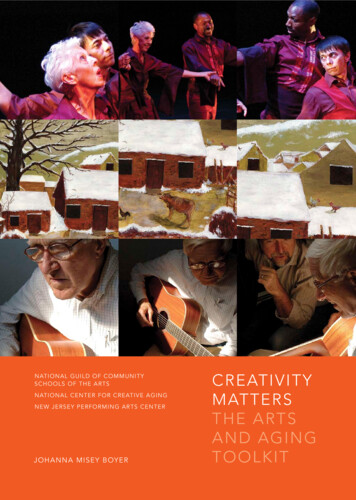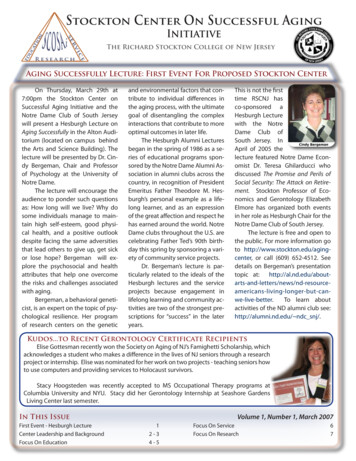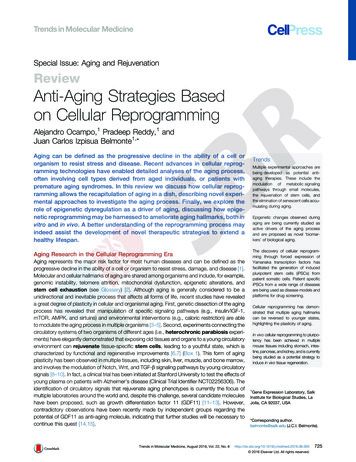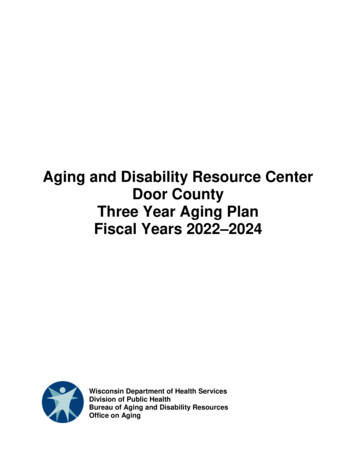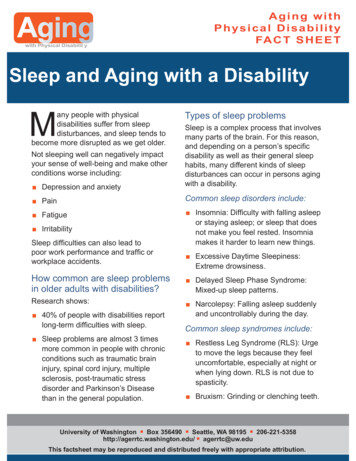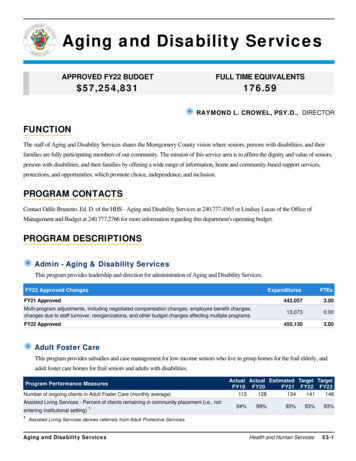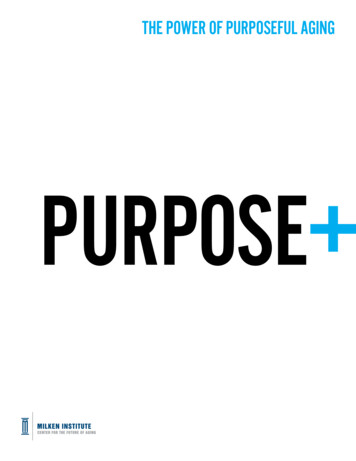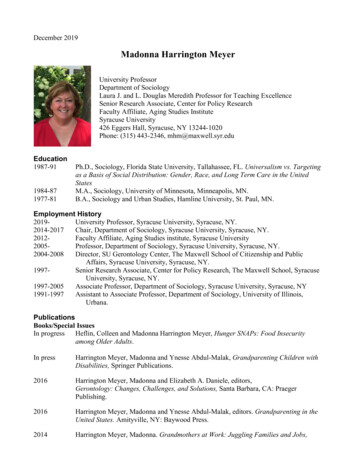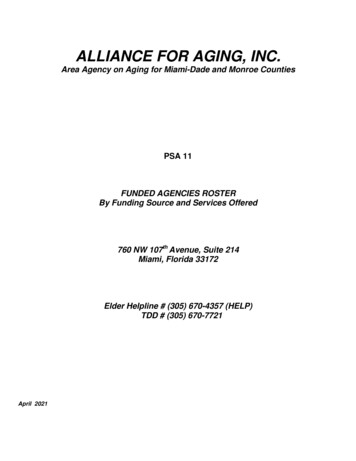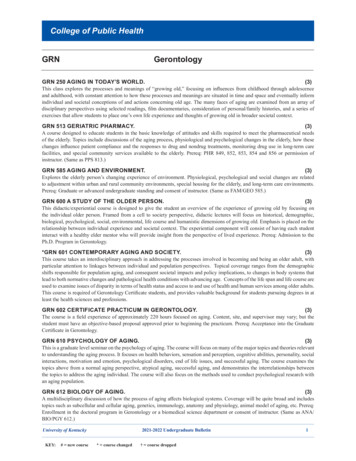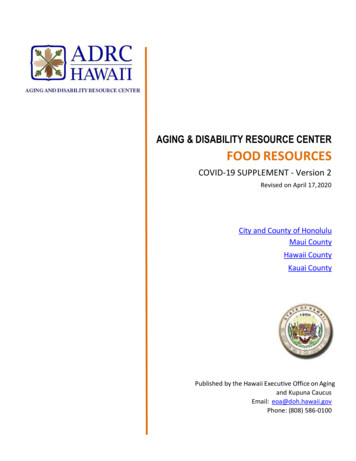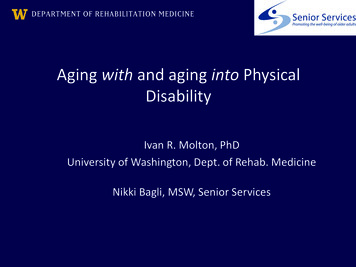
Transcription
Aging with and aging into PhysicalDisabilityIvan R. Molton, PhDUniversity of Washington, Dept. of Rehab. MedicineNikki Bagli, MSW, Senior Services
We’re all getting older - Currently 12.4% of US Population are 65 (37.3 million)- By 2030, expected to be 20.4% (71.5 million)
Older adults are only the same in thatthey’re so different Older adults show more intergroupvariability than do younger adults inalmost all areas– Cognitive abilities Crystallized intelligence Complex reasoning and problem-solving– Emotional functioning Depression, anxiety, happiness
We see the most variability inphysical functioning andcapability
Aging into Disability Increasing age is associated with greater risk ofdisability due OPDCoronary Heart DiseasePeripheral vascular diseaseDementiaDiabetic Complications Peripheral neuropathy Limb loss– Bone frailty
What about those aging with disability?
Aging “with” disability In 2010, 29.5 million Americans aged 21-64 (16.6% ofthe working age population) reported physicaldisabilities 260,000 individuals with SCI 350,000 individuals with MS 100,000 individuals with CMT 177,000 individuals with post-polio syndrome Each year, 1.7 million TBI’s
Aging with disability. Those with disability are living longer Example: SCI– In 1940, average life expectancy post-SCI was 18months– In 2005, average life expectancy with SCI isapproximately 85% of normal ( 68 years)– This means that in the past 50 years survival for persons with SCI has increased2000% percent survival for the nondisabled population hasincreased only 30%
Aging among traditional rehab populations: A diverse group withsimilar needs. Spinal Cord Injury– Average age now 40 years– 40% are over age 45– Average age at onset increased from 28.7 to 38.0 from 1973 Multiple Sclerosis– Mean age 49-53 years– 42% over the age of 65 Post-polio syndrome– 90% are over the age of 55 Cerebral Palsy– Death in childhood is now rare (about 2%)– 86% live past age 50
Aging “with” versus aging “into” disabilityShared challenges, shared needsAging “into” disabilitiesOsteoarthritisCOPDVascular dementiaCoronary artery diseaseOsteoporosisDiabetes (complications)limb lossperipheral neuropathiesProblems with balanceAging “with” disabilitiesRisk of fallsSpinal cord injuryChronic painTraumatic brain injuryRisk for infectionsNeuromuscular diseaseRisk for fracturesMultiple sclerosisNeed for caregiverDevelopmental disabilitiessupportPost-polio syndromeCognitive impairmentDepression/withdrawalChanges invision/hearingMobility limitations
Common goals: Research:– Identify key health conditions and ameliorate theirimpact– Understand trajectories of ability and disability acrossthe lifespan– Describe protective and risk factors for disease anddisability progression Intervention– Develop interventions and evidence based practicesto maximize function, participation, and communityliving
Silos and barriers to collaboration Separate funding and policy streams(e.g., NIH, ACL) Lack of capacity building and cross-training Jargon & Terminology“Multiple Chronic Conditions” or “Secondary HealthConditions,”“Disability” or “Frailty”
Different philosophies“For the disabilities system,aging is a success; for theaging network, disability is afailure.”Ansello, E. (2004). Public policy writ small: Coalitions at the intersections of aging and lifelong disabilities. Public Policy and AgingReport, 14(4), 3-6.
Unique needs and challenges ofthose aging with disabilityor:What does the gerontologistneed to know?
For people with long-term physicaldisability, increasing life expectancy isoffset by increases in newtroublesome health conditions andgreater functional disability.
“Secondary Health Condition”Adifficulttermandalongstandingdebate. Increased weaknessOnerecentdefinition:a“physicalor Increased fatiguepsychological health condition whose Worsening balancedevelopment or trajectory is influenced by the Increasedspasticitypresence of a disability or impairment.” Persistent pain- SCI Model Systems SIG on Aging, 2011 New sensory changes New sleep disturbance Depression
Secondary conditions: Chronic PainpercentAbout 30% report pain as “severe and chronic”
Troublesome symptoms in adults aging with disability:Comparison to national normsUS general population orage group mean1SD 1SDAmtmann et al., 2012; NIDRR H133B080024
There is emerging evidencefor a decreased margin ofhealth in adults aging withdisability.
ReserveCapacity30%Capacity100Theoretical model of reserve capacity.2040Age6080100
Why do these symptoms andconditions matter? Troublesome secondary symptoms and newmedical comorbidities represent– Threats to participation– Threats to independent living– Risks for premature retirement– Contribute to reduced quality of life
When in life are secondaryconditions most impactful forpeople with long-term physicaldisabilities?MIDDLE AGE – RUBBER MEETS ROAD
In nondisabled people, 45-64 is astressful time– Peak financial burden, parenting demands, preretirement planning, more “daily hassles” In people with disability, there is all ofthis plus worsening 2ndry healthconditions, declining health, earlierinvoluntary retirement
In persons with disability, middle-age isassociated with– Highest rates of depression– Highest rates of falls and fall-related injuries– Highest rates of pain and pain interference– Highest levels of fatigue
FatigueCook et al., 2011; NIDRR H133B080024
Pain interferenceMolton et al., 2012; NIDRR H133B080024
So where’s the “retirement bonus?” This age group may be associated with– Highest levels of expectations for performance– Onset of new secondary health conditions– For some disabilities, ongoing degeneration– Involuntary decreases in work, associated withfinancial pressures– Harder time doing valued activities
What factors make it easier? Access to good health care Personal “resilience”, or ability to bounce back fromadversity Treatment of secondary health conditions Physical exercise (within reason) Support from family and friends Ability to stay in the workforce
Social support in older adults Older adults have smaller, more selective socialnetworks than do younger adults This probably involves intentional selection of closerpartners (i.e., “social trimming”) Older women tend to receive support from largerand more empathetic sources than do older men Bereavement is a real issue: over the age of 65, 51%of women and 13.6% of men have lost a spouse
Social support and disability Individuals aging with disability have unique socialsupport needs At least in SCI, most individuals rely on their spousesto fulfill the majority of these needs– (41% of men with SCI report that their wife is their “only”source of support) Individuals with disabilities are less likely to marry,and have higher than average divorce rates (21%) Individuals aging with disability report that theircaretakers are also aging
What about employment?
Older workers now outnumberteens in the workforceNorthwest ADA CenterUniversity of Washington
More older workers are full time employeesBureau of Labor Statistics 2008Northwest ADA CenterUniversity of Washington
Employment in those withdisabilities 78% of people with disabilities are not inthe workforce Higher for people of color Most people with disabilities wouldprefer to work Most people with disabilities can work
Rates of employment In persons with MD, 32-40% maintainemployment. Average age to stop working with CMT is 46 30% of those with MS maintain employment For people with SCI,– about 60% were employed before accident– only about 30% are employed 5 years later.
Barriers to employment for people agingwith a disability in the US Irrational subsidy system Necessity of close access to rehab care Functional limitations associated with theprimary disability Functional limitations associated with secondaryconditions such as pain, fatigue, cognitivechanges Social and environmental access issues Lack of vocational rehabilitation and relatedservices
“Successful Aging”:a troublesome notion
A brief history of the“successful” aging concept First used by social scientists in the 1960’s and1970’s to describe the “best adapted” olderadults Initially, a slew of terms–––––Positive agingHealthy agingSuccessful AgingProductive AgingElite Aging
What elements make up “successful” aging? Not clearly established– Maintained physiological function– The absence of disease– Longevity– Physical activity– Emotional vitality– Intact cognitive function
Similarities between models Almost all models of successful aging emphasize–––––Maintenance or preservation of functional capacityPhysical activitySocial EngagementFreedom from chronic illness“Low probability of disease and disease-relateddisability” and “a high level of physical and cognitivefunction”.
What’s wrong with this picture? “Low probability of disease and diseaserelated disability” and “a high level of physicaland cognitive function”. 26 of 29 published definitions of “successful”aging note the absence of major chronicconditions or disability as necessary
What’s wrong with this picture? Over age 65, 2/3rds suffer from multiple chronicconditions contributing to physical disability These individuals utilize 65% of the US healthcarebudget Only 10-12% of the world population over 75would meet this criteria Such models do not account foraccommodations and adaptations
How do older adults define successful aging? Most older adults report themselves to be“aging successfully” despite not meetingobjective health criteria When asked to create their own definition,older adults emphasize– Free time– Time spent with family/friends– Greater psychological resilience– Better everyday function
What about successful aging for those with long-termphysical disability? “Low probability of disease and disease-relateddisability” and “a high level of physical andcognitive function”. 67 year old woman with Relapsing/Remittingmultiple sclerosis– Mild cognitive impairment– Difficulties in ambulation Regardless of her level of community engagement,life quality, satisfaction, and activity, she has “failed”at aging
Successful aging in Disability In one study of participants with MS,successful aging was described in terms of– Maintained social engagement– Effective and accessible health care– Maintaining independence at home– Ability to communicate effectively with onescaregivers
What should a mode of successful aging in Disabilityinclude? 6 UW Focus Groups; Older individuals withdisability asked to define “successful aging” Tools to manage secondary Conditions Maintenance of valued activities withadaptations Access to healthcare– Physical and transportation barriers– Limited access to assistive tech– Limited access to specialists
A model of “Successful Aging” witha disability Maintain participation in important activities Stay socially connected Use assistive devices or technologies to enhancequality of life Adjust expectations for performance to physicalhealth Stay in a chosen work area, with reasonableaccommodations Get good access to medical, and rehab care
Modified model from Young, Frick, &Phelan (2009)Domains ofsuccessful agingPhysiologicalMgmt of 2ndry conditions;adaptations to maximizefunctionAccess to HealthcarePsychologicalPositive psychologicaloutcomesSociologicalParticipation in valuedactivities
There is a need for community based,evidenced health promotion programs foradults aging with as well as into disability.
For older adults, many options
Were people with physical disabilitiesincluded in this evidence base? Much of the evidence base for theseinterventions has systematically excluded thoseaging with long-term physically disablingconditions– Studies have required participants to be “ambulatory” “without a chronic health condition that limits participation” “not wheel-chair bound”
Evidence-Based WellnessProgramsNikki Bagli, MSWSenior Services
What is an Evidence-based Program? Based on scientific reasoning, behavior changetheory, and program planning Proven effective in achieving desired outcomes Improves health status Employs a process of planning, implementing, andevaluating programs adapted from tested modelsor interventions
Evidence-Based Programs Developedand Disseminated at Senior Services
Health Enhancement Program Study* Northshore Senior Center, 1998 Objective: Increase health and functioning of frailolder adults using a self-management, senior centerbased approach 201 participants 70 recruited through medicalpractices 100 in intervention group* Leveille SG, et al. (1998). Preventing disability and managing chronic illness in frail older adults: Arandomized trial of a community-based partnership with primary care. Journal of American GeriatricsSociety, 46:1-9.
Health Enhancement Program Study Outcomes Intervention group showed less decline in function Hospitalized participants decreased by 38% Inpatient hospital days was significantly less (72%) (33days) Significantly higher levels of physical activity andsenior center participation Significant reductions in the use of psychoactivemedications
Poll: Has yourdoctor ever told youto do something youknow would be goodfor you, but youdon’t do it?
Features of Individualized and participant-drivenSocial Worker and/or Registered NurseMotivational InterviewingHealth Behavior Stages of ChangeParticipant directed action planningSelf-management supportStandardized tests for pre and post outcomes
Participant Questionnaire
Motivational InterviewingA collaborative, clientcentered, goal-directed,communication style thatengages intrinsic motivationwithin the client in order tochange behavior.
Health Behavior Stages of ChangeHealth BehaviorStages of Change Pre-contemplation Contemplation Preparation Action Maintenance
Goals are: Something the client wants to do Achievable Specific What How much When How often Confidence level of 7 or moreSuccess begets success!
EnhanceWellness EARLSOtherCommunityActivities &ServicesMatter ofBalance
EnhanceWellness Service ProcessReferral by Staff/Health Care Provider/SelfContact by EW StaffFirst VisitSecond VisitSix Month Graduation
Data Management
What results doesproduce?In older adults, studies show that the program reversesfunctional decline: 72% decrease in hospital days 35% decrease in psychoactive drugs 11% decrease in depression 18% decrease in physical inactivity
Most frequent target areas inEnhanceWellnessTop Issues SelectedMaintainedImprovedMaintained/Improved1. Exercise34%48%82%2. Nutrition31%46%77%3. Feelings26%59%85%4. Health Self-Management36%46%82%5. Social Activity31%55%85%
EnhanceWellness Dissemination 90’s – King County; 2000’s – other states Affiliates purchase license Affiliate staff trained in EnhanceWellness process andmotivational interviewing; Counselor Manual WellWare - online data entry system for participant andprogram data
States with EnhanceWellness Sites ColoradoIndianaMassachusettsMissouriNew JerseySouth CarolinaWashington
Who is an average EW participant? Female (74%)White (81%)Age 60 (84%)Very Low Income (42%)High BP (64%)Arthritis (62%)Depression/Anxiety (40%)
Questions?Dr. Sabine ThomasSenior Director, Health and Wellness206-268-6736 sabinet@seniorservices.orgPaige DenisonEnhanceFitness National Trainer425-830-2819 .projectenhance.org
Adapting EnhanceWellnessIvan MoltonUniversity of Washington
Adapting the Program RationaleStakeholder engagementProgram modificationsMethodsChallengesPreliminary DataParticipant Feedback
RationalePartner with a large non-profit communityservice organization, already delivering anintervention to older adults endorsed by theNational Council on Aging, and test the utilityand efficacy of this intervention in people agingwith long-term physical disability (LTPD). Ifproven efficacious, testing the project in a realworld setting allows for more efficientdissemination.
Stakeholder Engagement Focus groups with consumers Advisory board meetings with researchers,community providers Two-day training for community providers on:Medical Aspects of Disability Secondary Conditions Employment & Benefits Sexuality and Disability Legal Issues Ableism Cognition AssistiveTechnology Physical Activity and Falling Concerns
Program Modifications Eligibility criteria– Age ( 45)– Living in King County Meeting locations Program length Physical therapist consult
Methods 120 adults with MS, MD, PPS or SCI Separate research outcomes collected pre- and post-program. Inclusion Criteria:––––Minimum age 45Self-reported physician diagnosis of MS, MD, SCI or PPSLiving in King County, WAAble to read and understand English Exclusion:– Active suicidal ideation– Use of mechanical ventilator to breathe or speak Two thank you payments of 50 for completion of researchsurveys
Methodological Challenges Outcome measures– Fatigue– Physical Activity– Self-efficacy– Psychotropic medication use
Enrollment To Date 54 Enrolled 36 Complete Waitlist in place since the beginning;significant interest in the program
Case example 61 yo woman with MS, living alone, income 18,000 Goal Topic: Falling– Task 1: re-start yoga practice Task 1 barriers: heat, out of shape (confidence level “10”)– Task 2: Register for the matter of balance workshop at theNorth Shore Senior Center Task 2 barriers: timing/schedule (confidence level “10”)– Task 3: purchase a non-slip bath mat Task 3 barriers: gross mold, cost (confidence level “10”)
Participant Goals Address:– Physical activity, socialization, strength & endurance,organization, maintaining independence, downsizing,weight loss, smoking & alcohol cessation, decreasing falls Examples:––––To create balance in my lifeTo be more social and write moreTo lose 10 lbs., become agile and build muscleTo feel more sexy (?)
Preliminary Results Mean age: 64 (range 57 – 79) 26 with MS, 4 with SCI, 5 with PPS Primarily female (67%), with at least a collegedegree (60%) and identified asWhite/Caucasian (94%)
Pain Interference Measured using the PROMIS Pain InterferenceShort Form. “In the past 7 days, how much did paininterfere with your day to day activities?” “In the past 7 days, how much did paininterfere with your ability to participate insocial activities?– Not at all, a little bit, somewhat, quite a bit, verymuch
Pain Interference
Preliminary Results – Pain InterferencePROMIS Pain Interference T Score:N 33, t(32) 1.98; p .06Amtmann, D. A., Cook, K. F., Jensen, M. P., Chen, W-H., Choi, S. W., Revicki, D., Cella, D., Rothrock, N., Keefe, F.,Callahan, L., Lai, J-S. (2010). Development of a PROMIS item bank to measure pain interference. Pain, 150(1), 173-82.
Falls PrevalenceAgeReported falling at least once in the past 6 monthsAll(n 1826)MS(n 571)MD(n 332)PPS(n 439)SCI(n 484)All Ages977 (54%)311 (55%)231 (70%)242 (55%)193 (40%)18-44149 (15%)45 (15%)42 (18%)1 (0.4%)61 (32%)45-54234 (25%)94 (30%)78 (34%)8 (3%)54 (28%)55-64345 (35%)119 (38%)67 (29%)104 (43%)55 (29%) 65249 (25%)53 (17%)44 (19%)129 (53%)23 (12%)Matsuda P N, Verrall AM, Finlayson ML, Molton IR, Jensen MP. "Falls Among Adults AgingWith Disability." Arch Phys Med Rehabil. 2015.
Fear of FallingFalls Efficacy Scale – International (FES-I)“For each of the following activities, please check the box which is closest to your ownopinion to show how concerned you are that you might fall if you did this activity.Not at all Somewhat FairlyVeryconcerned concerned Concerned Concerned1. Getting dressed orundressed 2. Taking a bath orshower 3. Getting in or out ofa chair
Preliminary Results – Fear of FallingCommunity dwelling olderadults (norm)*FES- I;N 30, t(29) 2.63, p .01;*Gertrudis IJM, Kempen JM, Yardley L, et al. (2007) “The Short FES-I: a shortened version of the falls efficacy scaleinternational to assess fear of falling. Age Ageing: 37(1): 45-50.
Additional positive findings Increase in leisure physical activity:– 23.46 to 33.43, n 35; p .03 Increase in satisfaction with social roles:– 45.12 to 48.43, n 34; p .01 Decrease in fatigue:– Fatigue 10.88 to 9.68, n 34; p .02 Decrease in anxiety (n 19):– Anxiety 9.0 to 8.0, n 19; p .05
Treatment satisfaction Treatment Satisfaction––––Helpfulness: mean 7.67 (0 – 10 NRS)Benefits outweighed the effort: 15 (42%)Equaled the effort: 15 (42%)Efforts outweighed benefit: 1
Negative findings No significant changes in– Community Integration– Global Quality of Life– Sleep Disturbance– Depression
Follow-up Interviews Qualitative interviews conducted with arandom sample of 10% of all participants– Overall satisfaction with the program– Issues with access (if programs weren’t nearby, itwas hard to meet the goals in between visits)– Some programs were cost-prohibitive
Participant Reflections“I’m doing better than I have since I got my injury.”(SCI)“I don’t feel rudderless anymore.”“I had been wanting to do this and you pushed me overthe edge!”“This program has been "life changing,” ”I’ve alwaystaken care of others and now, I'm on the list.”“You recognized what I needed and gave me a reasonfor doing it.”
“Aging with Grace”https://youtu.be/HSvEs2NzmEk?t 2m55s
Future plans for dissemination Finalize manual; distribute to sites providingEnhanceWellness Provide web based training module ondisability to EnhanceWellness coaches Provide ongoing supervision/training supportto EnhanceWellness coaches National level RCT?
Thank YouQuestions?http://agerrtc.washington.edu/Healthy Aging RRTC@AgingRRTC
EnhanceWellness Citations Leveille SG, et al. (1998). Preventing disability and managing chronic illnessin frail older adults: A randomized trial of a community-based partnership withprimary care. Journal of American Geriatrics Society, 46:1-9. Phelan EA, et al. (2002). Outcomes of a Community-Based Dissemination ofthe Health Enhancement Program. Journal of American Geriatrics Society,50:1,519-1,524. Phelan EA, et al., (2003). Promoting health and preventing disability in olderadults: Lessons from intervention studies carried out through an academiccommunity partnership. Family Community Health; 26:214-20. Phelan EA, et al. (2004). Activities of daily living function and disability inolder adults in a randomized trial of the Health Enhancement Program.Journals of Gerontology Series A: Biological Sciences and Medical Sciences,59A(8): 838-843.
disability" and "a high level of physical and cognitive function". 67 year old woman with Relapsing/Remitting multiple sclerosis - Mild cognitive impairment - Difficulties in ambulation Regardless of her level of community engagement, life quality, satisfaction, and activity, she has "failed" at aging
